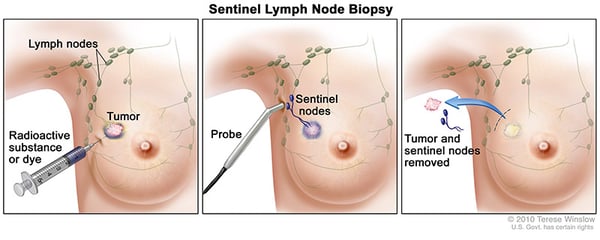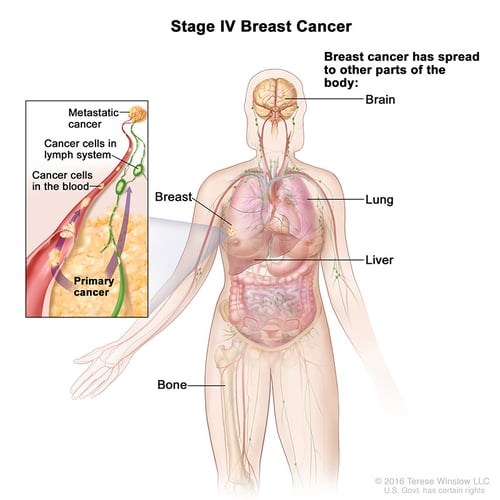Breast Cancer Staging
Breast Cancer
- Breast Cancer Overview
- Newly Diagnosed
- Signs & Symptoms
- Detecting & Diagnosing
- Types of Breast Cancer
- Hormone Receptor Status
- Lymph Node Involvement
- Staging
- Treatment Options
- Breast Cancer Surgery
- Breast Cancer Recurrence
- Breast Reconstruction
- Risk Factors
- Genetics & Breast Cancer
- Breast Cancer FAQs
- Living as a Survivor
If the biopsy shows that you have breast cancer, your doctor needs to learn the extent (stage) of the disease to help you choose the best treatment. The stage indicates the cancer's size and whether it has spread to nearby tissues, lymph nodes, or beyond the breast.
Tests Used to Stage Breast Cancer
Staging breast cancer may involve blood tests and other tests:
- Bone scan: The doctor injects a small amount of a radioactive substance into a blood vessel. It travels through the bloodstream and collects in the bones. A machine called a scanner detects and measures the radiation. The scanner makes pictures of the bones. The pictures may show cancer that has spread to the bones.
- CT scan: Doctors sometimes use CT scans to look for breast cancer that has spread to the liver or lungs. An X-ray machine linked to a computer takes a series of detailed pictures of your chest or abdomen. You may receive contrast material by injection into a blood vessel in your arm or hand. The contrast material makes abnormal areas easier to see.
- MRI Scan. Like a CT scan, this examines the soft tissues in your body, such as the brain or spinal cord, to look for signs of breast cancer.
- PET Scan. Often used alongside a CT scan, a PET scan can detect where cancer cells may be developing in the body, even before a tumor becomes apparent.
- Lymph node biopsy: The stage often is not known until after surgery to remove the tumor in your breast and one or more lymph nodes under your arm. Surgeons use a method called sentinel lymph node biopsy to remove the lymph node most likely to have breast cancer cells. The surgeon injects a blue dye, a radioactive substance, or both near the breast tumor. Or the surgeon may inject a radioactive substance under the nipple. The surgeon then uses a scanner to find the sentinel lymph node containing the radioactive substance or looks for the lymph node stained with dye. The sentinel node is removed and checked for cancer cells. Cancer cells may appear first in the sentinel node before spreading to other lymph nodes and other places in the body.

These tests can show whether the cancer has spread and, if so, to what parts of your body. When breast cancer spreads, cancer cells are often found in lymph nodes under the arm (axillary lymph nodes). Also, breast cancer can spread to almost any other part of the body, such as the bones, liver, lungs, and brain.
When breast cancer spreads from its original place to another part of the body, the new tumor has the same kind of abnormal cells and the same name as the primary (original) tumor. For example, if breast cancer spreads to the bones, the cancer cells in the bones are actually breast cancer cells. The disease is metastatic breast cancer, not bone cancer. For that reason, it is treated as breast cancer, not bone cancer. Doctors call the new tumor “distant” or metastatic disease.
Related Reading:
What is Metastatic Breast Cancer?

Stages of Breast Cancer
Breast cancer staging is categorized on a scale of 0 through IV. Breast cancer in stage 0 describes non-invasive cancers that remain within their original location, and stage IV breast cancer describes invasive cancers that spread to other parts of the body.
The stages of breast cancer are described below:
Stage 0 Breast Cancer
Stage 0 is sometimes used to describe abnormal cells that are not invasive cancer. For example, Stage 0 is used for ductal carcinoma in situ (DCIS). DCIS is diagnosed when abnormal cells are in the lining of a breast duct, but the abnormal cells have not invaded nearby breast tissue or spread outside the duct. Although many doctors don’t consider DCIS to be cancer, DCIS sometimes becomes invasive breast cancer if not treated.
Stage I Breast Cancer
Stage I is an early stage of invasive breast cancer. Cancer cells have invaded breast tissue beyond where the cancer started, but the cells have not spread beyond the breast. The tumor is no more than 2 centimeters (three-quarters of an inch) across.
Stage II Breast Cancer
Stage II is one of the following:
- The tumor is no more than 2 centimeters (three-quarters of an inch) across. The cancer has spread to the lymph nodes under the arm.
- The tumor is between 2 and 5 centimeters (three-quarters of an inch to 2 inches). The cancer has not spread to the lymph nodes under the arm.
- The tumor is between 2 and 5 centimeters (three-quarters of an inch to 2 inches). The cancer has spread to the lymph nodes under the arm.
- The tumor is larger than 5 centimeters (2 inches).
The cancer has not spread to the lymph nodes under the arm.
Stage III Breast Cancer
Stage III is locally advanced cancer. It is divided into Stage IIIA, IIIB, and IIIC.
- Stage IIIA is one of the following:
- The tumor is no more than 5 centimeters (2 inches) across. The cancer has spread to underarm lymph nodes that are attached to each other or to other structures. Or the cancer may have spread to lymph nodes behind the breastbone.
- The tumor is more than 5 centimeters across. The cancer has spread to underarm lymph nodes that are either alone or attached to each other or to other structures. Or the cancer may have spread to lymph nodes behind the breastbone.
- Stage IIIB is a tumor of any size that has grown into the chest wall or the skin of the breast. It may be associated with swelling of the breast or with nodules (lumps) in the breast skin:
- The cancer may have spread to lymph nodes under the arm.
- The cancer may have spread to underarm lymph nodes that are attached to each other or other structures. Or the cancer may have spread to lymph nodes behind the breastbone.
- Inflammatory breast cancer is a rare type of breast cancer. The breast looks red and swollen because cancer cells block the lymph vessels in the skin of the breast. When a doctor diagnoses inflammatory breast cancer, it is at least Stage IIIB, but it could be more advanced.
Read our blog, What is Inflammatory Breast Cancer?, to learn more about this type of breast cancer.
- Stage IIIC is a tumor of any size. It has spread in one of the following ways:
- The cancer has spread to the lymph nodes behind the breastbone and under the arm.
- The cancer has spread to the lymph nodes above or below the collarbone.
Stage IV Breast Cancer
Stage IV is distant metastatic breast cancer. The cancer has spread to other parts of the body, such as the bones or liver.

Recurrent Breast Cancer
Recurrent cancer is cancer that has come back after a period of time when it could not be detected. Even when cancer seems to be completely destroyed, the disease sometimes returns because undetected cancer cells remain somewhere in your body after treatment. Breast cancer can return as a local recurrence (in the same breast), regional (in the lymph nodes nearby the breast), or in a distant area of the body. Treatment for recurrent breast cancer is typically different from the initial breast cancer treatment, as it is more aggressive and difficult to treat.
Breast Cancer Centers at Willamette Valley Cancer Institute
If you or a loved one has received a new breast cancer diagnosis, our oncologists are here to guide you. Our breast cancer doctors work with each patient to understand their specific type of breast cancer and recommend a personalized treatment plan based on you. We offer a patient-centered approach to cancer care and have access to the latest breast cancer treatments at our cancer centers throughout Willamette Valley, including Albany, Corvallis, Eugene, Florence, Lincoln City, and Newport, Oregon.
